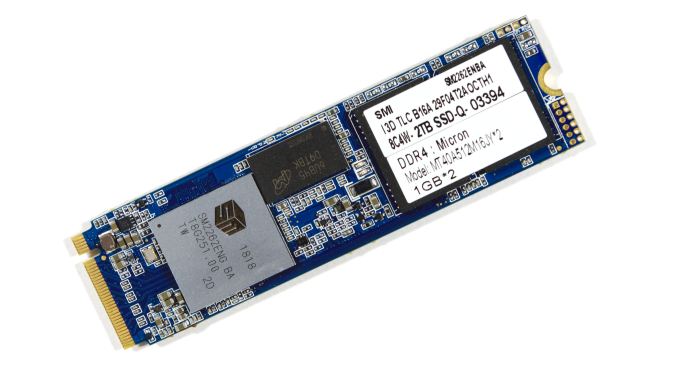
Original Link: https://www.anandtech.com/show/13131/the-silicon-motion-sm2262en-ssd-controller-preview
The Silicon Motion SM2262EN SSD Controller Preview: Good And Bad Amplified
by Billy Tallis on August 1, 2018 11:45 AM EST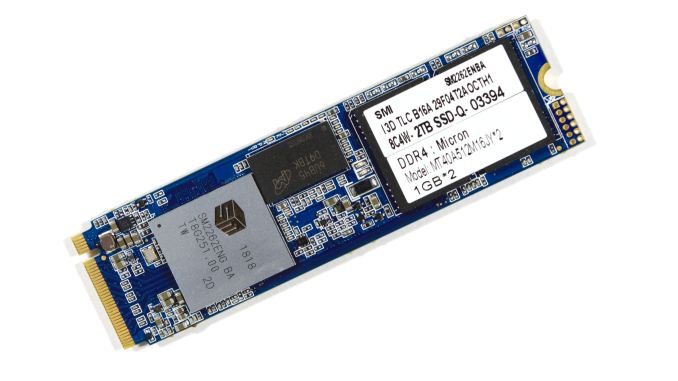
Silicon Motion's second-generation NVMe SSD controllers have all but taken over the consumer NVMe SSD market. Drives like the HP EX920 and ADATA SX8200 currently offer great performance at prices that are far lower than what Samsung and Western Digital are charging for their flagship products. These Silicon Motion-based SSDs are using the SM2262 controller - the high-end member of SMI's current lineup - but they're almost as cheap as the entry-level NVMe drives that use low-end controllers with limited performance. Phison's second-generation high-end E12 controller still hasn't hit the shelves, so Silicon Motion has no serious competition for the SM2262.
But Silicon Motion isn't standing still. They've prepared an update to the SM2262 controller called the SM2262EN. This was first previewed at the same time that the SM2262 was announced, but Silicon Motion didn't provide much guidance on the timing. The SM2262 controller hit the market with the Intel SSD 760p in January, and the SM2262EN is almost ready for release. With the SM2262EN, Silicon Motion is promising substantial performance improvements that go well beyond what we usually see from firmware optimizations, though the hardware changes relative to the SM2262 are minimal. The updated controller should hit the market in time to compete against Phison E12 SSDs and the first wave of drives with 96-layer 3D NAND.
| Silicon Motion NVMe SSD Controller Comparison | |||||
| Controller | SM2262EN | SM2262 | SM2263 | SM2263XT | SM2260 |
| Host Interface | PCIe 3.0 x4 | ||||
| Protocol | NVMe 1.3 | NVMe 1.2 | |||
| NAND Flash Channels | 8 | 8 | 4 | 4 | 8 |
| NAND Chip Enable lines | 4 | 4 | 4 | 4 | 4 |
| NAND interface speed | 800 MT/s | 667 MT/s | 533 MT/s | ||
| Typical NAND | IMFT 64L 3D TLC | IMFT 32L 3D MLC/TLC | |||
| DRAM Support | DDR3(L), LPDDR3, DDR4 |
No (HMB* supported) |
DDR3(L), LPDDR2 |
||
| DRAM Bus Width | 32/16-bit | 16-bit | N/A | 32/16-bit | |
| Controller Package | 18x16mm 472-ball TFBGA |
12x12mm 288-ball TFBGA |
18x16mm 472-ball TFBGA |
||
| Sequential Read MB/s | 3500 | 3200 | 2400 | 2400 | 2400 |
| Sequential Write MB/s | 3000 | 1900 | 1700 | 1700 | 1000 |
| Random Read IOPS | 420k | 370k | 300k | 280k (HMB*) 120k (no HMB*) |
120k |
| Random Write IOPS | 420k | 300k | 250k | 250k | 140k |
| *HMB = Host Memory Buffer - where an SSD uses system DRAM to save cost by not having any of its own | |||||
To assess the new SM2262EN controller solution, Silicon Motion has provided us with a 2TB reference design SSD with their latest firmware, a work in progress as Silicon Motion continues to optimize performance. This is a higher capacity drive than any of the SM2262 SSDs we've tested, and some performance improvement may be due simply to the capacity increase. However, even at 1TB we already have several NAND dies on each of the controller's 8 channels, so adding more dies shouldn't have a huge impact, especially not for sequential transfers.
| SM2262EN Engineering Sample Specifications | |
| Usable Capacity | 2000 GB |
| Controller | Silicon Motion SM2262EN |
| Firmware Version | SVN112 |
| NAND Flash | Intel 64-layer 256Gb 3D TLC |
| Form-Factor | double-sided M.2 2280 |
| Interface | PCIe 3 x4 |
| DRAM | 2GB Micron DDR4-2400 CL16 |
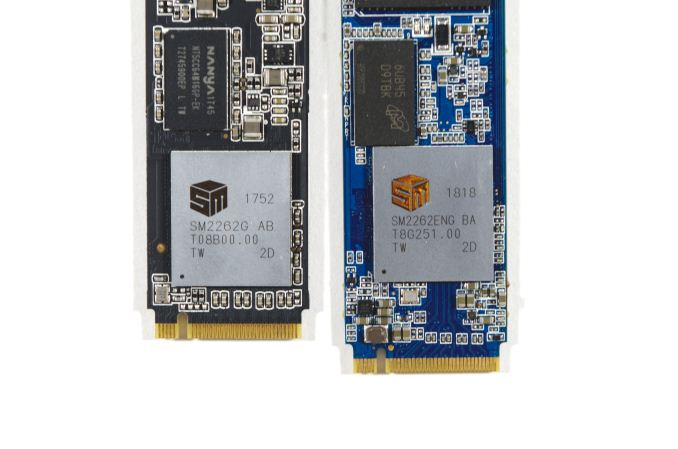
SM2262 (left) and SM2262EN (right)
This 2TB configuration represents the maximum practical capacity when using 256Gb NAND dies, as it requires four packages with stacks of sixteen dies. The usable capacity is configured as about 2000 GB. The PCB layout is generally the same as for the SM2262 drives we've seen, with one DRAM package and two NAND packages on each side. This drive uses 2GB of Micron DDR4 DRAM, while all of the SM2262 retail drives we've seen use DDR3L.
The switch to DDR4 gives a slight improvement to voltage and latency, and a big boost to throughput—which is probably necessary to make the most of the EN controller variant. The use of DDR4 does add slightly to the cost of the drive, but not enough to prevent this change from carrying over into retail products. The DRAM update still leaves Silicon Motion a bit behind Samsung, which has moved its SSDs to LPDDR4 and reaped significant power savings.
For this review, the 2TB SM2262EN drive is compared against other recent NVMe SSDs, primarily high-end drives. The results from our engineering sample of the upcoming Phison E12 controller are also included, and these two new controller solutions will probably be responsible for the stiffest competition in the NVMe SSD market segment once they are both shipping in volume.
| AnandTech 2018 Consumer SSD Testbed | |
| CPU | Intel Xeon E3 1240 v5 |
| Motherboard | ASRock Fatal1ty E3V5 Performance Gaming/OC |
| Chipset | Intel C232 |
| Memory | 4x 8GB G.SKILL Ripjaws DDR4-2400 CL15 |
| Graphics | AMD Radeon HD 5450, 1920x1200@60Hz |
| Software | Windows 10 x64, version 1709 |
| Linux kernel version 4.14, fio version 3.6 | |
| Spectre/Meltdown microcode and OS patches current as of May 2018 | |
- Thanks to Intel for the Xeon E3 1240 v5 CPU
- Thanks to ASRock for the E3V5 Performance Gaming/OC
- Thanks to G.SKILL for the Ripjaws DDR4-2400 RAM
- Thanks to Corsair for the RM750 power supply, Carbide 200R case, and Hydro H60 CPU cooler
- Thanks to Quarch for the XLC Programmable Power Module and accessories
- Thanks to StarTech for providing a RK2236BKF 22U rack cabinet.
AnandTech Storage Bench - The Destroyer
The Destroyer is an extremely long test replicating the access patterns of very IO-intensive desktop usage. A detailed breakdown can be found in this article. Like real-world usage, the drives do get the occasional break that allows for some background garbage collection and flushing caches, but those idle times are limited to 25ms so that it doesn't take all week to run the test. These AnandTech Storage Bench (ATSB) tests do not involve running the actual applications that generated the workloads, so the scores are relatively insensitive to changes in CPU performance and RAM from our new testbed, but the jump to a newer version of Windows and the newer storage drivers can have an impact.
We quantify performance on this test by reporting the drive's average data throughput, the average latency of the I/O operations, and the total energy used by the drive over the course of the test.
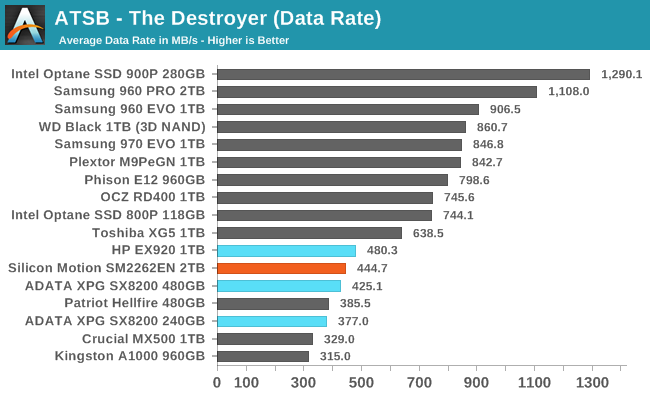
The Silicon Motion SM2262EN offers no improvement over the base SM2262 on The Destroyer, with an average data rate that is slightly below the HP EX920. These SMI controllers are providing performance that is well below the current standard for high-end NVMe drives.
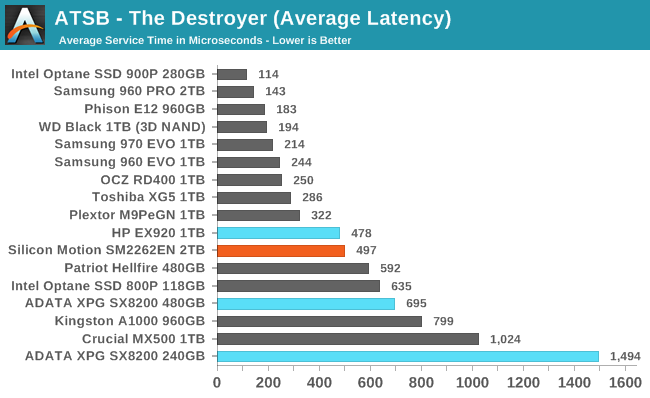
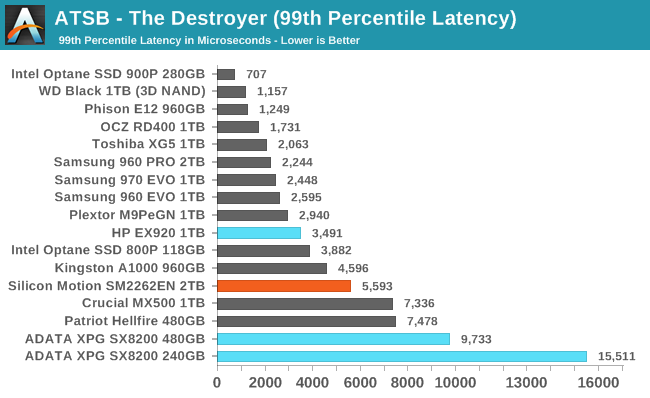
The average latency of the SM2262EN is only slightly worse than the HP EX920, but the 99th percentile latency has regressed more significantly into low-end NVMe territory.
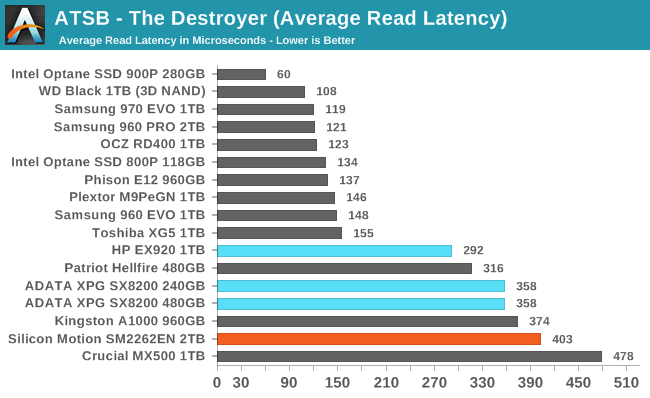
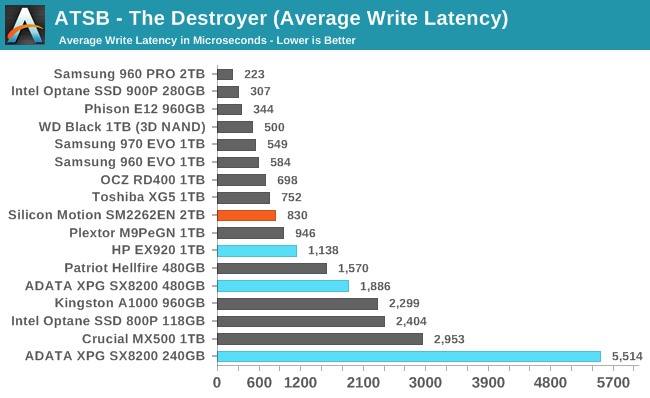
The average latency regression is due to degraded read latency, while average write latency has actually improved, though not to the point of being competitive with other high-end NVMe SSDs.
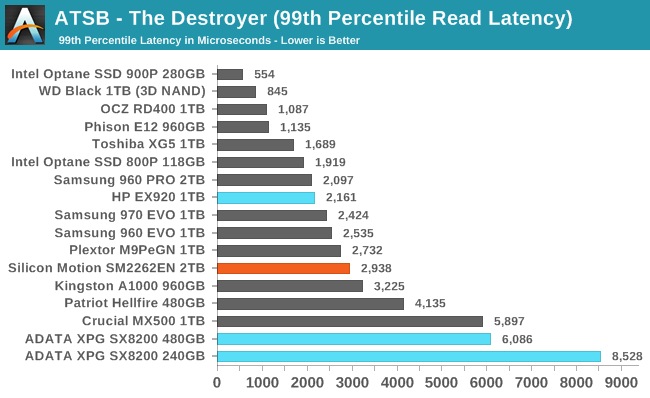
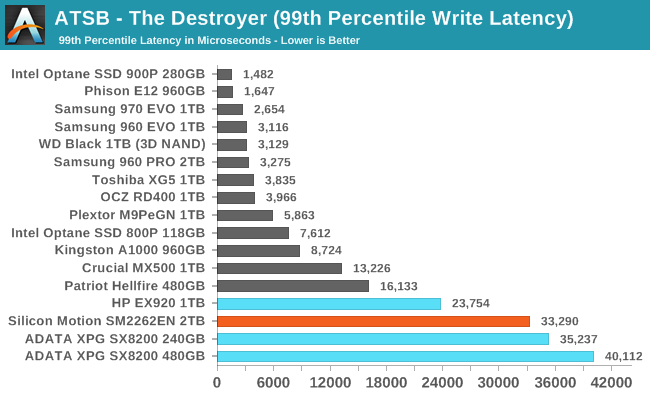
The 99th percentile read and write latencies are both worse for the SM2262EN than for the HP EX920, but the write latency is clearly the bigger problem with a larger overall value and a more significant regression.
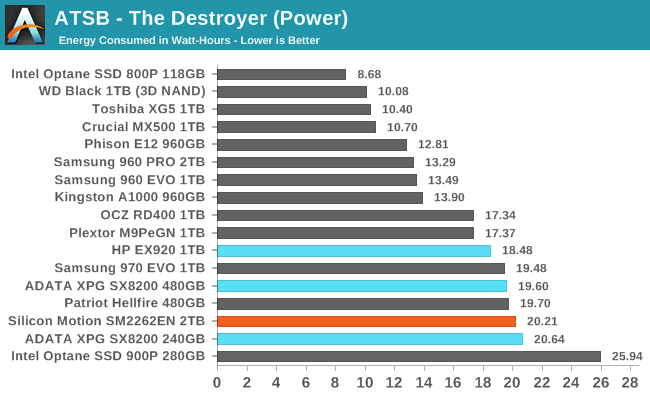
The energy usage of the SM2262EN during The Destroyer is a bit higher than for the HP EX920, which already used rather a lot of energy for not delivering high-end performance. The SM2262EN doesn't quite surpass the smallest, slowest SM2262 drive.
AnandTech Storage Bench - Heavy
Our Heavy storage benchmark is proportionally more write-heavy than The Destroyer, but much shorter overall. The total writes in the Heavy test aren't enough to fill the drive, so performance never drops down to steady state. This test is far more representative of a power user's day to day usage, and is heavily influenced by the drive's peak performance. The Heavy workload test details can be found here. This test is run twice, once on a freshly erased drive and once after filling the drive with sequential writes.
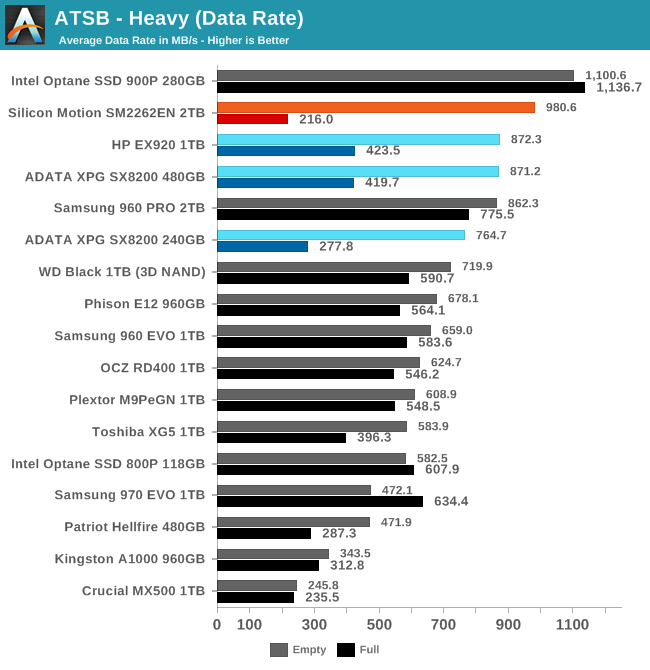
The SM2262EN improves on the SM2262's already class-leading performance on the Heavy test, with an average data rate that is about 12% higher. However, this comes at the cost of reduced performance when the test is run on a full drive—and that was already the biggest weakness of the SM2262 drives.
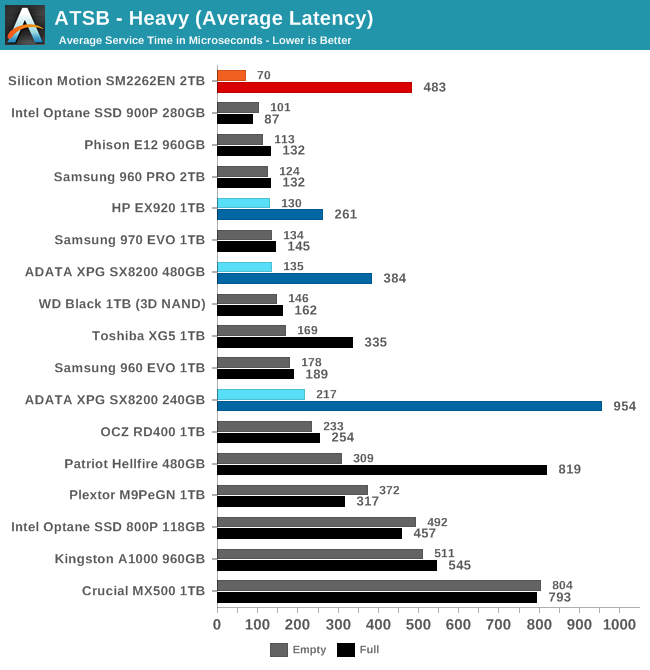
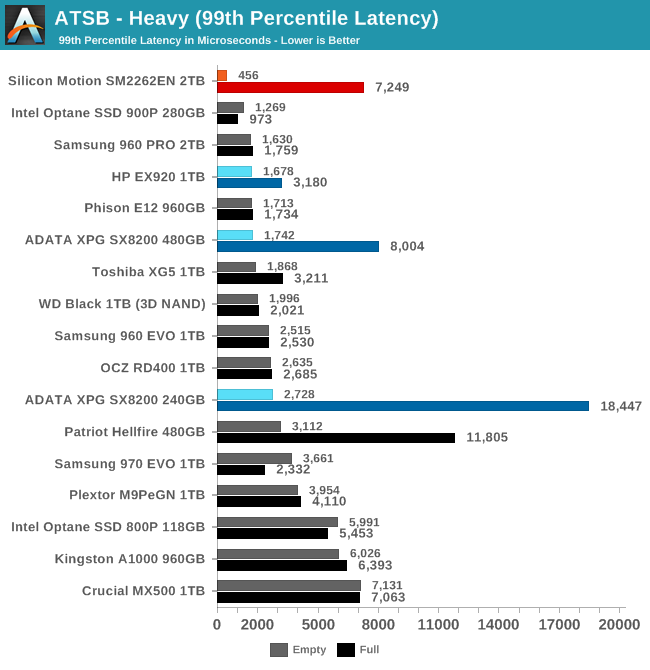
The average and 99th percentile latencies show an even more stark dichotomy in the SM2262EN's performance characteristics. When the Heavy test is run on a freshly-erased drive, the latency is impressively low and the 99th percentile QoS score is unprecedented. But when the drive fills up, it completely leaves the high-end performance bracket.
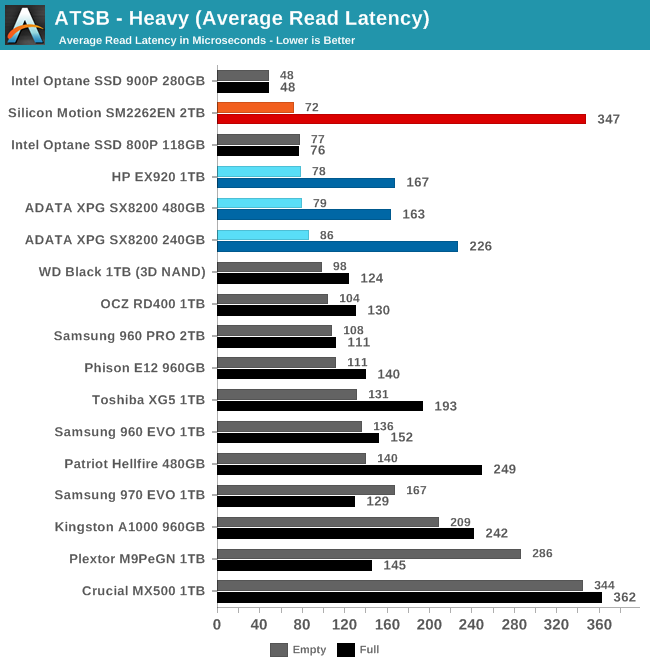
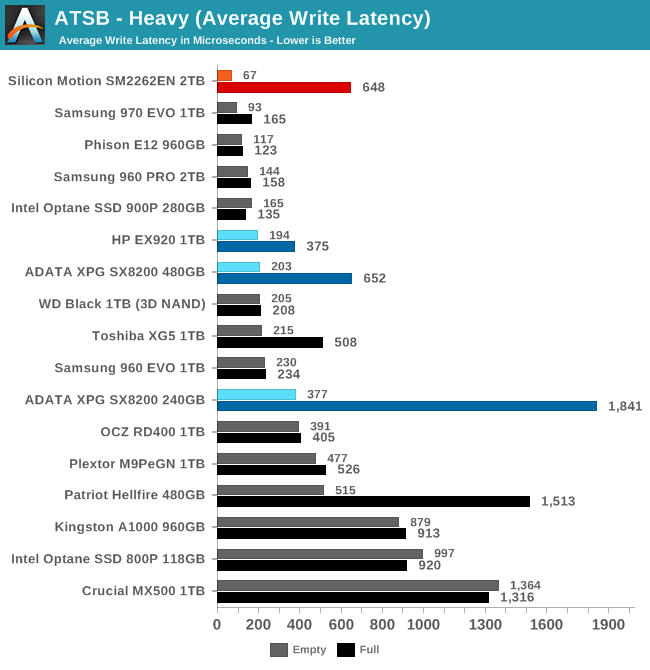
Under favorable conditions, the SM2262EN manages to beat the average read latency of the slower Optane SSD, and it offers the top-notch average write latency that the SM2262 drives couldn't quite manage. But when the drive is full, read latency gets pushed to SATA levels and write latency increases by an order of magnitude.
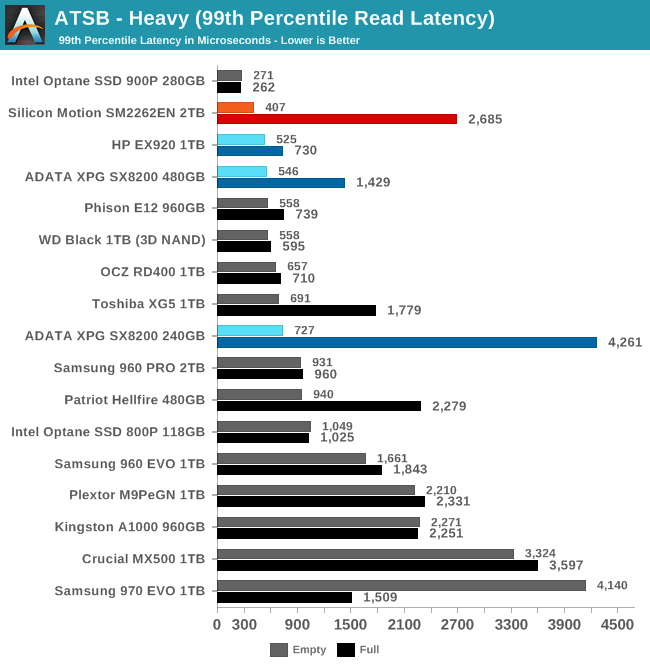
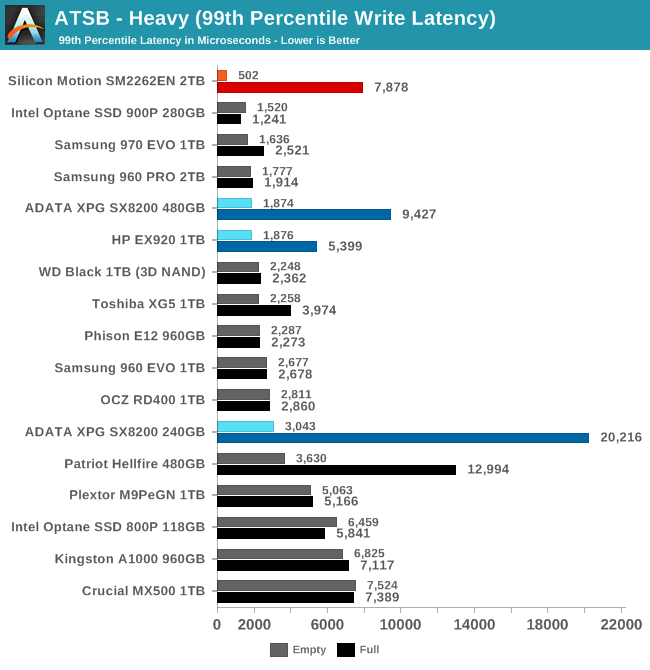
The 99th percentile write latency of the SM2262EN when the Heavy test is run on a freshly-erased drive is less than a third that of any other drive, and the 99th percentile read latency is second only to the Optane SSD 900P. When this drive has plenty of spare area and SLC cache space, it's extremely fast. But fill it up and we're back to low-end NVMe performance that's considerably worse than the 1TB HP EX920.
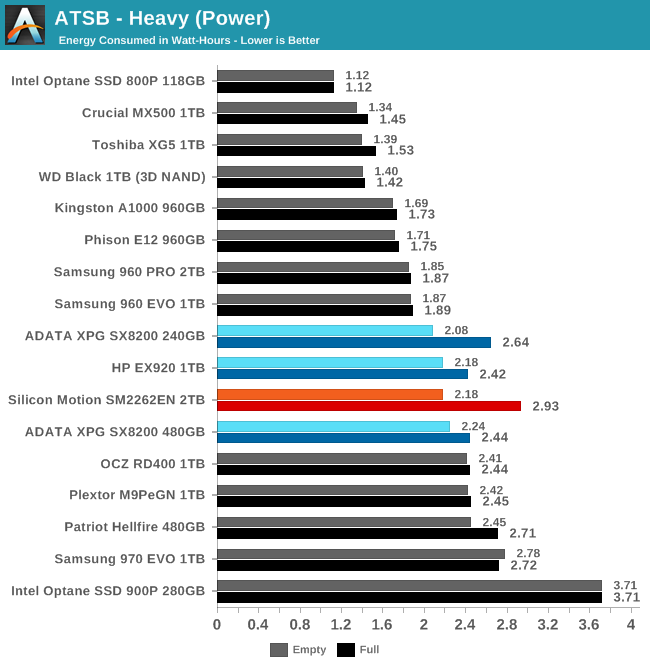
Energy usage by the SM2262EN drive on the Heavy test is comparable to the SM2262 drives, but with a much bigger disparity between the empty and full drive test runs. Even without the full-drive problems, this wouldn't be the best choice for a laptop.
AnandTech Storage Bench - Light
Our Light storage test has relatively more sequential accesses and lower queue depths than The Destroyer or the Heavy test, and it's by far the shortest test overall. It's based largely on applications that aren't highly dependent on storage performance, so this is a test more of application launch times and file load times. This test can be seen as the sum of all the little delays in daily usage, but with the idle times trimmed to 25ms it takes less than half an hour to run. Details of the Light test can be found here. As with the ATSB Heavy test, this test is run with the drive both freshly erased and empty, and after filling the drive with sequential writes.
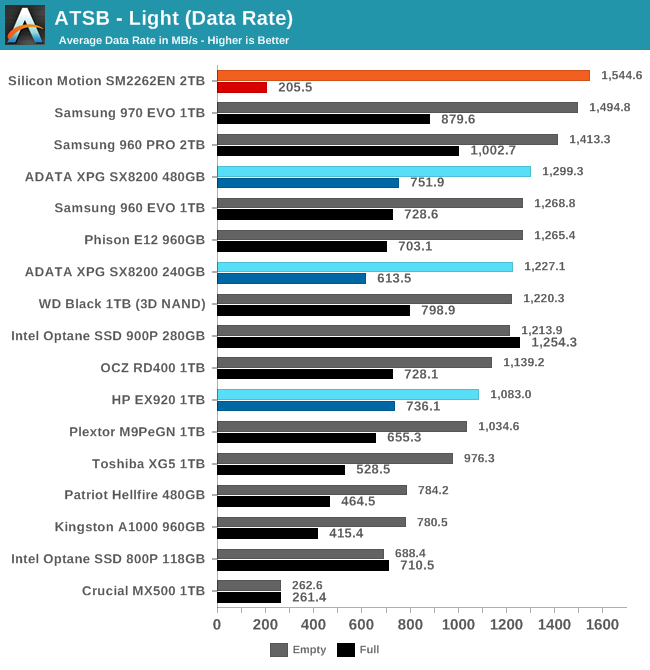
The difference between freshly-erased and full drive test run performance is greater for the Silicon Motion SM2262EN than for any other drive. The fresh out of the box performance on the Light test is faster than anything else we've tested, and the full-drive performance is below par for a mainstream SATA SSD. Where this drive transitions between these two modes and how steep that transition is will make or break the product.
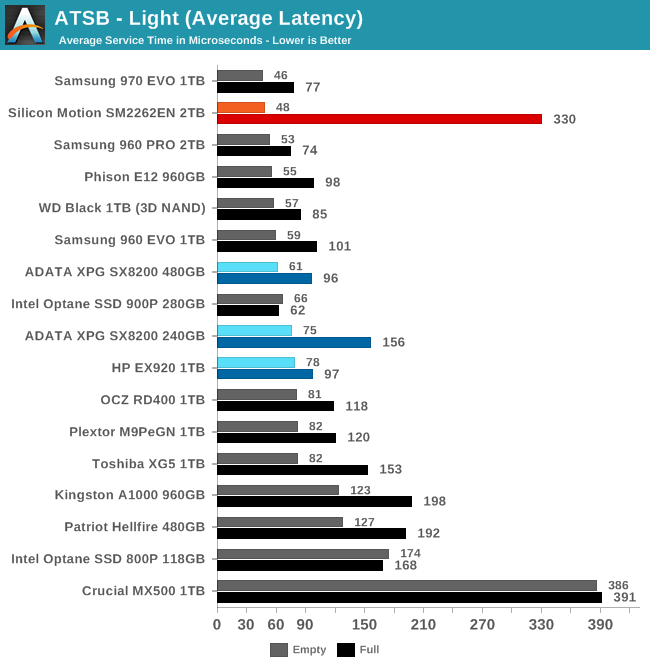
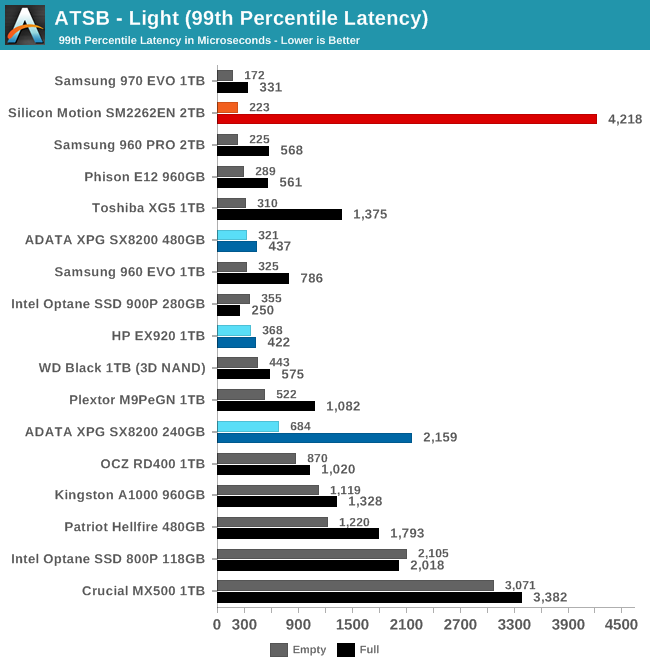
Despite having a slightly higher average data rate, the SM2262EN has slightly worse average and 99th percentile latency scores than the Samsung 970 EVO. When the drive is full, the average latency is almost as high as the Crucial MX500 SATA drive, and the 99th percentile latency is worse.
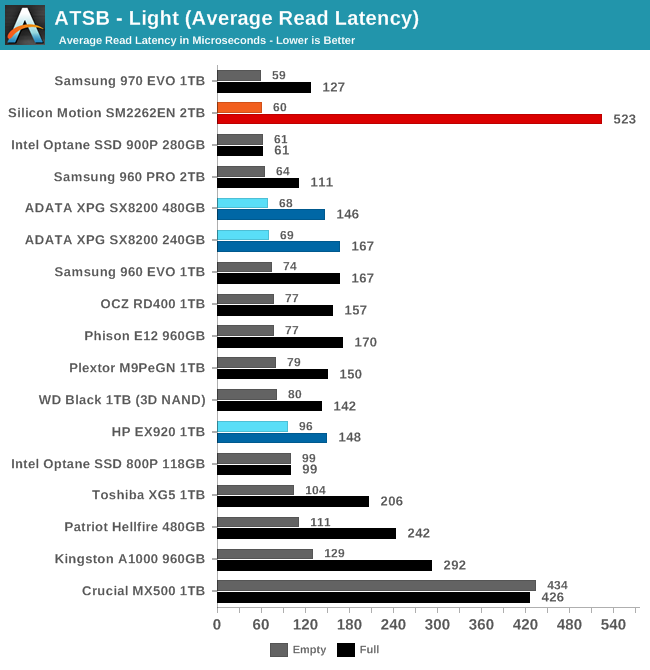
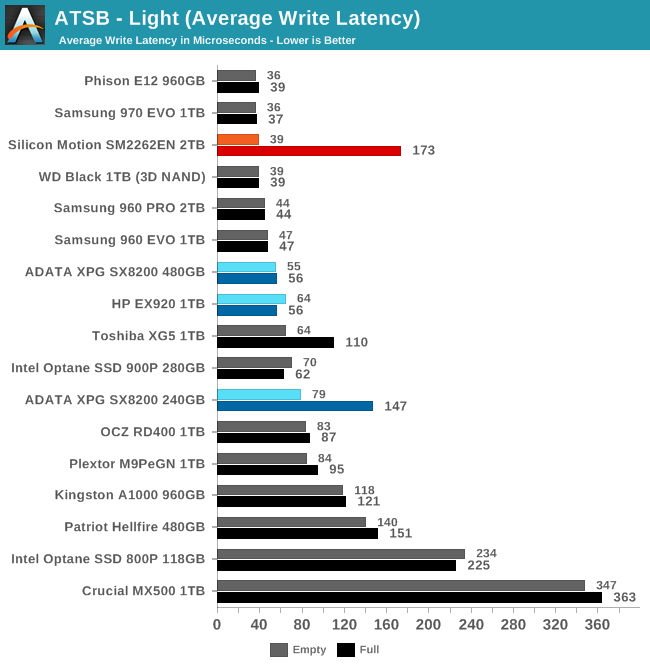 Average read and write latencies from the SM2262EN are more or less tied for first place when the test is run on an empty drive. When the drive is full the read latency is a bigger problem than write latency: reads are slower than the MX500, while writes stay in low-end NVMe territory.
Average read and write latencies from the SM2262EN are more or less tied for first place when the test is run on an empty drive. When the drive is full the read latency is a bigger problem than write latency: reads are slower than the MX500, while writes stay in low-end NVMe territory.
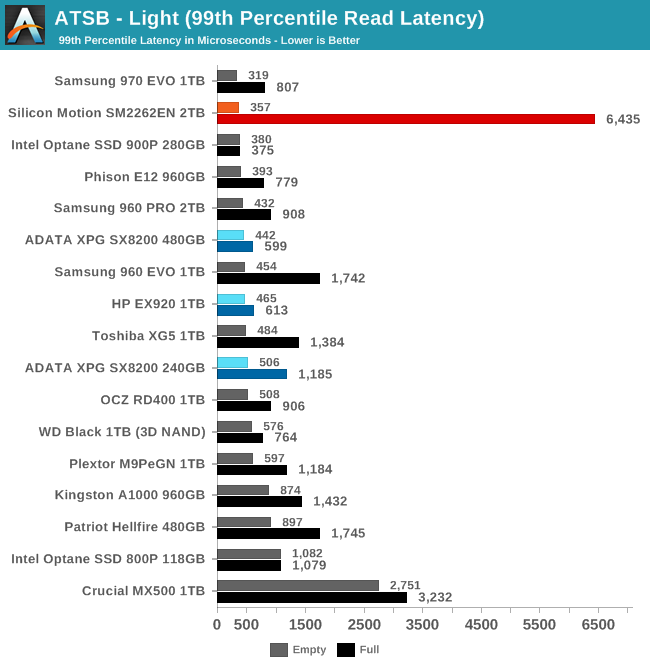
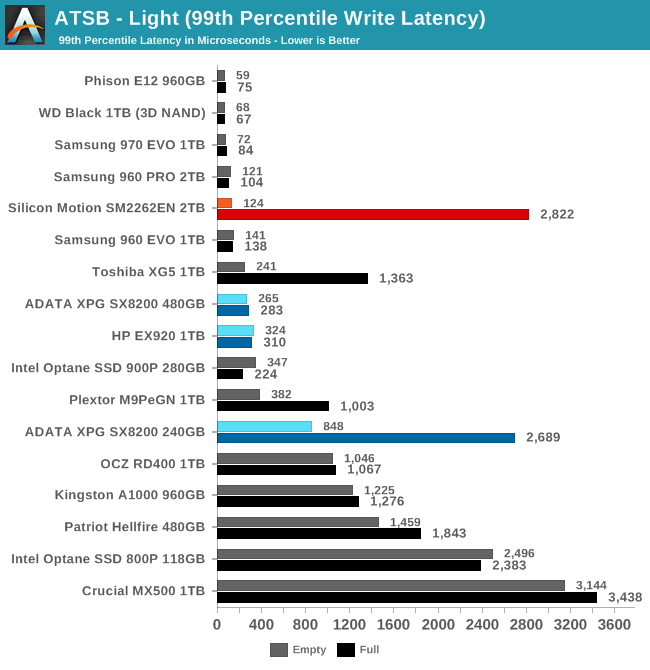
The 99th percentile read and write latency scores are good but not the best for the empty drive test run. When the SM2262EN is full, both scores are vastly worse, with the 99th percentile read latency ending up twice as slow as the Crucial MX500.
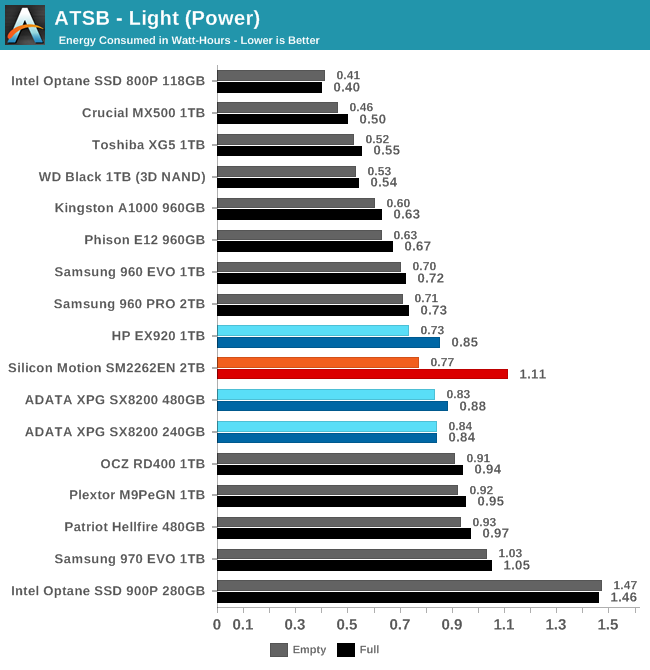
The SM2262EN's energy consumption during the Light test is slightly higher than average for the empty-drive test runs, and higher than any other M.2 drive when the test is run on a full drive.
Random Read Performance
Our first test of random read performance uses very short bursts of operations issued one at a time with no queuing. The drives are given enough idle time between bursts to yield an overall duty cycle of 20%, so thermal throttling is impossible. Each burst consists of a total of 32MB of 4kB random reads, from a 16GB span of the disk. The total data read is 1GB.
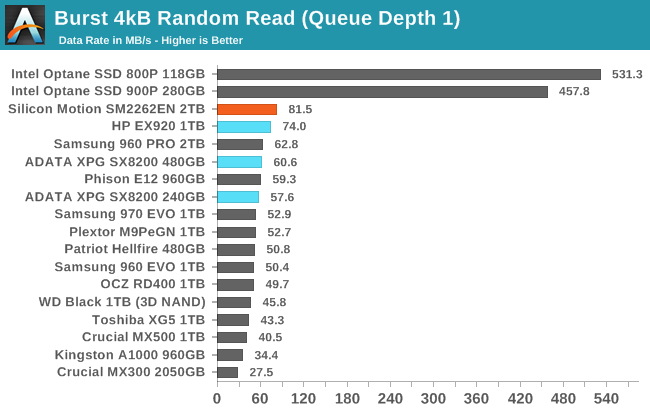
The 2TB SM2262EN drive expands on Silicon Motion's lead in random read performance with a 10% increase over the 1TB HP EX920's QD1 burst performance.
Our sustained random read performance is similar to the random read test from our 2015 test suite: queue depths from 1 to 32 are tested, and the average performance and power efficiency across QD1, QD2 and QD4 are reported as the primary scores. Each queue depth is tested for one minute or 32GB of data transferred, whichever is shorter. After each queue depth is tested, the drive is given up to one minute to cool off so that the higher queue depths are unlikely to be affected by accumulated heat build-up. The individual read operations are again 4kB, and cover a 64GB span of the drive.
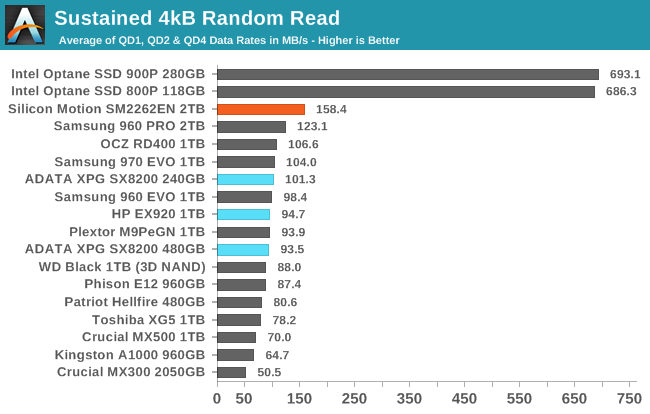
On the sustained random read test, the SM2262EN's standing is even better. Its predecessors were not able to beat the Samsung 970 PRO or MLC drives on the longer random read test, but the -EN does so with ease.
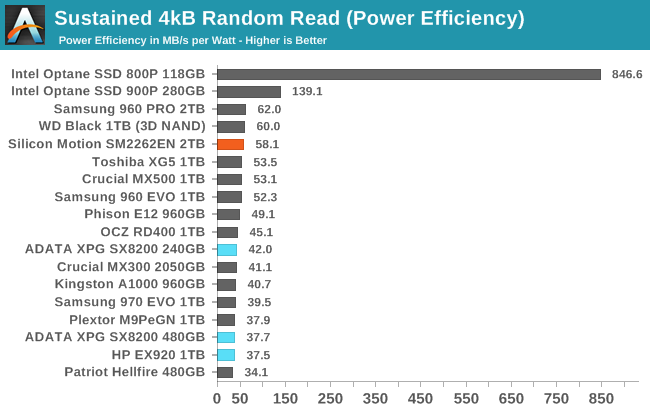 |
|||||||||
| Power Efficiency in MB/s/W | Average Power in W | ||||||||
The power consumption of the SM2262EN is a bit higher than for the SM2262 drives, which makes it the most power-hungry M.2 drive in this batch. But the performance is high enough that the efficiency score climbs to almost tie the best flash-based SSDs while the older SM2262 drives had quite poor scores here.
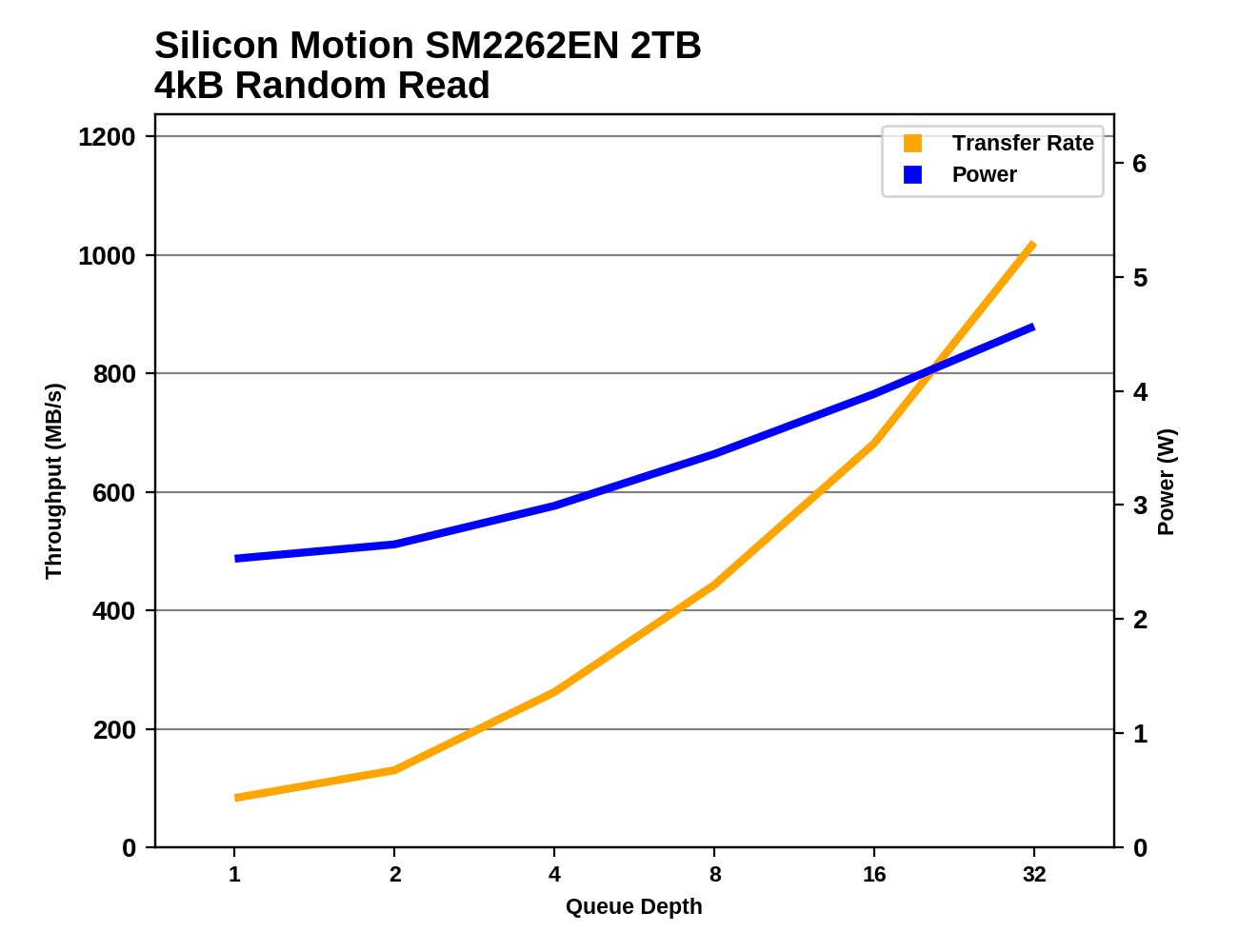 |
|||||||||
The SM2262EN's lead seems to be strongest at low queue depths, which is what's most important for consumer workloads. The Samsung 960 PRO passes the SM2262EN at QD8 and the 970 EVO and WD Black are closing in at higher queue depths. By QD32 the SM2262EN is approaching the throughput of Intel's Optane SSDs.
Random Write Performance
Our test of random write burst performance is structured similarly to the random read burst test, but each burst is only 4MB and the total test length is 128MB. The 4kB random write operations are distributed over a 16GB span of the drive, and the operations are issued one at a time with no queuing.
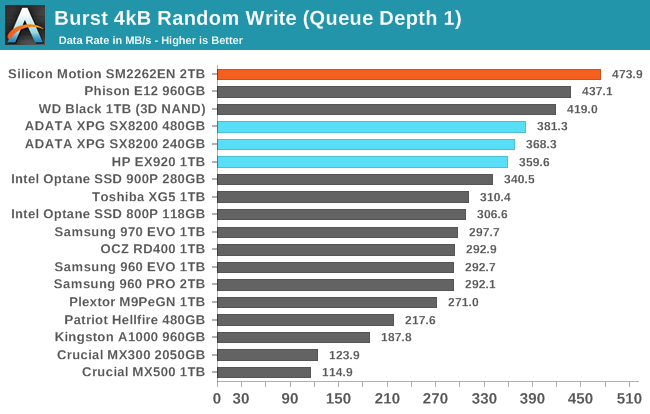
The SM2262EN takes first place in the burst random write test, showing that it has the fastest SLC write cache. It is 8% faster than the Phison E12 engineering sample we tested and 25-30% faster than the SM2262 drives we have tested.
As with the sustained random read test, our sustained 4kB random write test runs for up to one minute or 32GB per queue depth, covering a 64GB span of the drive and giving the drive up to 1 minute of idle time between queue depths to allow for write caches to be flushed and for the drive to cool down.
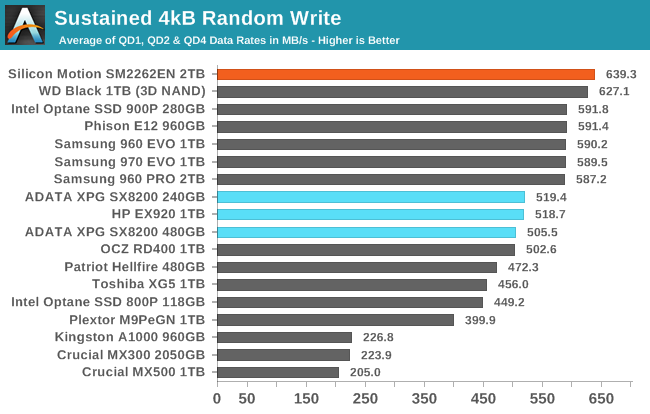
On the longer random write test, the SM2262EN hangs on to first place, though with a much narrower lead of about 2% over the WD Black. The test is still short enough to be working only with the SLC write cache for the 2TB SM2262EN drive.
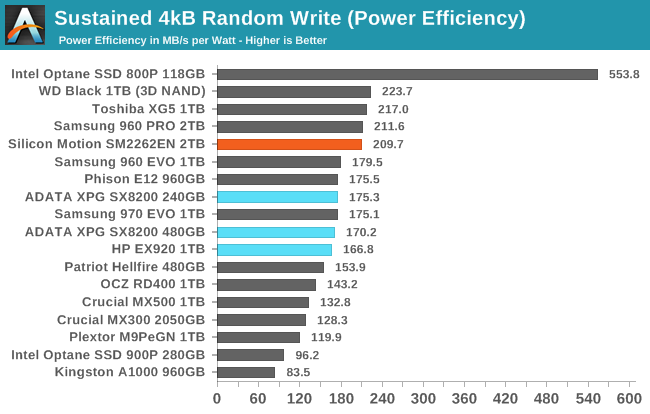 |
|||||||||
| Power Efficiency in MB/s/W | Average Power in W | ||||||||
The performance boost the SM2262EN brings is enough to boost its efficiency score into the top tier, though it still isn't quite matching the efficiency of the WD Black. In absolute terms, power consumption is actually slightly lower than the 1TB HP EX920.
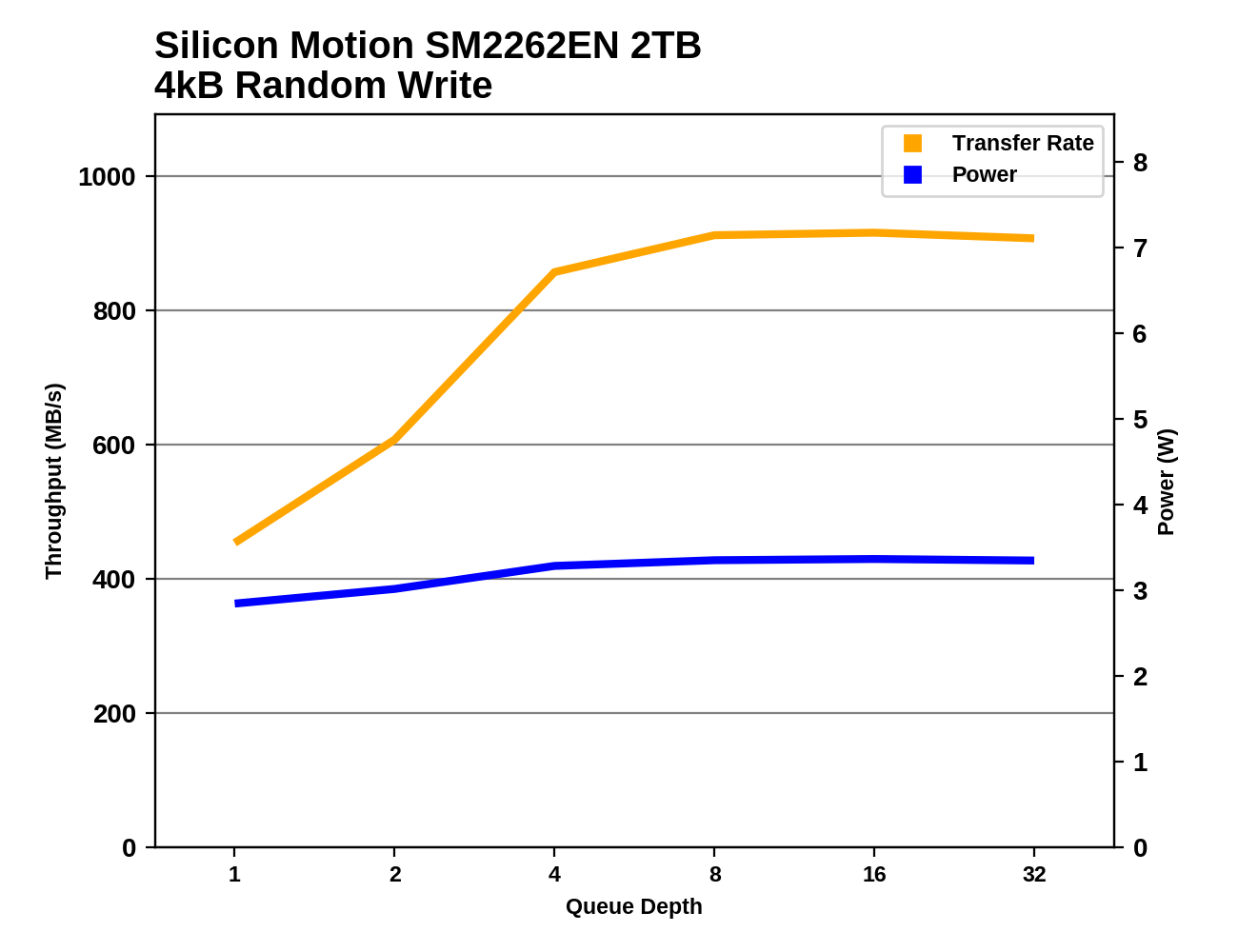 |
|||||||||
The SM2262EN has the best random write performance at low queue depths, but by QD4 the other top NVMe SSDs have caught up or slightly surpassed it. At QD8 and higher, performance holds steady and the SLC cache never gets entirely filled during this test.
Sequential Read Performance
Our first test of sequential read performance uses short bursts of 128MB, issued as 128kB operations with no queuing. The test averages performance across eight bursts for a total of 1GB of data transferred from a drive containing 16GB of data. Between each burst the drive is given enough idle time to keep the overall duty cycle at 20%.
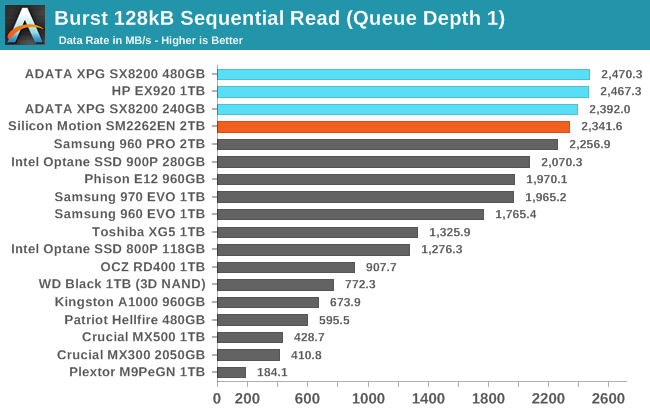
The burst sequential read performance from the Silicon Motion SM2262EN is slightly below what we've measured for earlier SM2262 drives, but it's still well ahead of any competing TLC drive.
Our test of sustained sequential reads uses queue depths from 1 to 32, with the performance and power scores computed as the average of QD1, QD2 and QD4. Each queue depth is tested for up to one minute or 32GB transferred, from a drive containing 64GB of data. This test is run twice: once with the drive prepared by sequentially writing the test data, and again after the random write test has mixed things up, causing fragmentation inside the SSD that isn't visible to the OS. These two scores represent the two extremes of how the drive would perform under real-world usage, where wear leveling and modifications to some existing data will create some internal fragmentation that degrades performance, but usually not to the extent shown here.
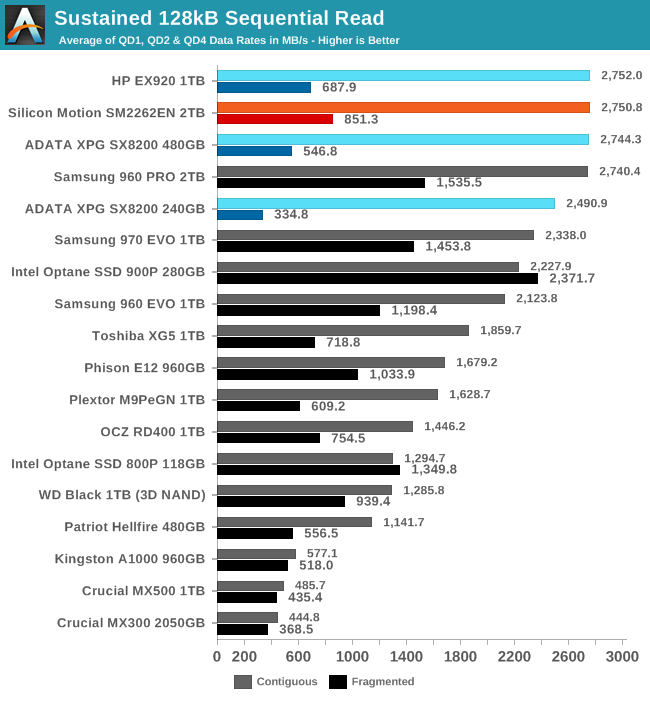
The sustained sequential read performance of the SM2262EN is identical to the SM2262 drives we've tested, and tied with the Samsung 960 PRO. The 2TB -EN drive has better performance than the SM2262 drives when reading from a drive with severe internal fragmentation, but there's still a lot of room for improvement here.
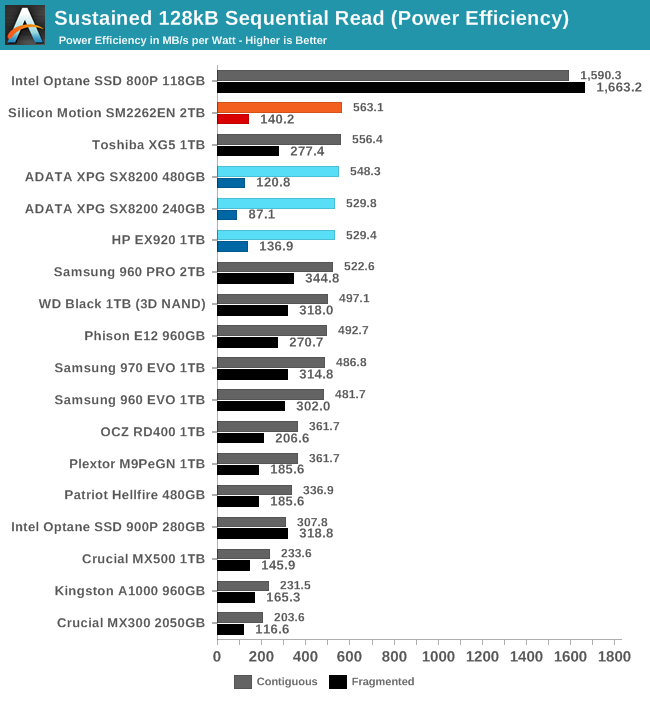 |
|||||||||
| Power Efficiency in MB/s/W | Average Power in W | ||||||||
Power efficiency from the SM2262 drives was already very good on this test, and the SM2262EN brings an incremental improvement. Efficiency when reading from a drive with internal fragmentation is also slightly improved, but overall power consumption in that case is now over 6W, which is pushing it a bit for an M.2 drive that is being fed by only a 3.3V supply.
 |
|||||||||
The SM2262 drives hit their full sequential read at QD2, but the SM2262EN takes a bit longer to get up to its limit. The eventual performance is only a little bit shy of the 3.5GB/s that Silicon Motion's specifications promised.
Sequential Write Performance
Our test of sequential write burst performance is structured identically to the sequential read burst performance test save for the direction of the data transfer. Each burst writes 128MB as 128kB operations issued at QD1, for a total of 1GB of data written to a drive containing 16GB of data.
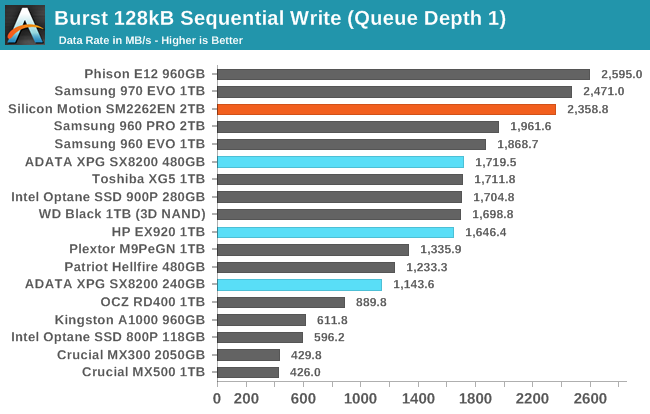
The burst sequential write speed of the SM2262EN is a substantial jump over what the plain SM2262 provides, but it's not quite enough to put the -EN at the top of the chart. The upcoming Phison E12 holds on to that spot for now, and the Samsung 970 EVO is also still ahead of the SM2262EN.
Our test of sustained sequential writes is structured identically to our sustained sequential read test, save for the direction of the data transfers. Queue depths range from 1 to 32 and each queue depth is tested for up to one minute or 32GB, followed by up to one minute of idle time for the drive to cool off and perform garbage collection. The test is confined to a 64GB span of the drive.
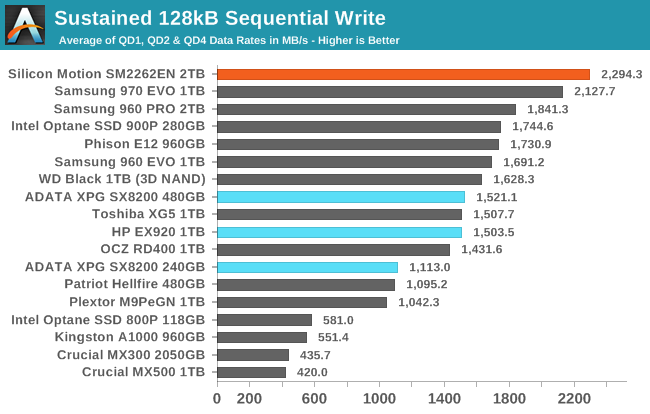
The SM2262EN does manage to take first place on the longer sequential write test, though some of this may be due to its capacity advantage over most of the other drives we have available to compare against. The 2TB 970 EVO is likely quite close to the SM2262EN, given how the 1TB 970 EVO performs.
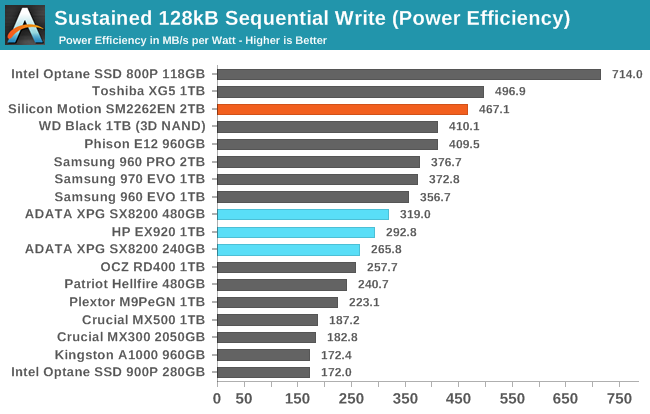 |
|||||||||
| Power Efficiency in MB/s/W | Average Power in W | ||||||||
The SM2262EN provides a 50% performance boost over its predecessor while dropping power consumption by a quarter of a Watt relative to the 1TB HP EX920, so it is no surprise to see the efficiency score leap upwards. Silicon Motion is now ahead of the WD Black and the Phison E12, and is almost as efficient as the much slower Toshiba XG5.
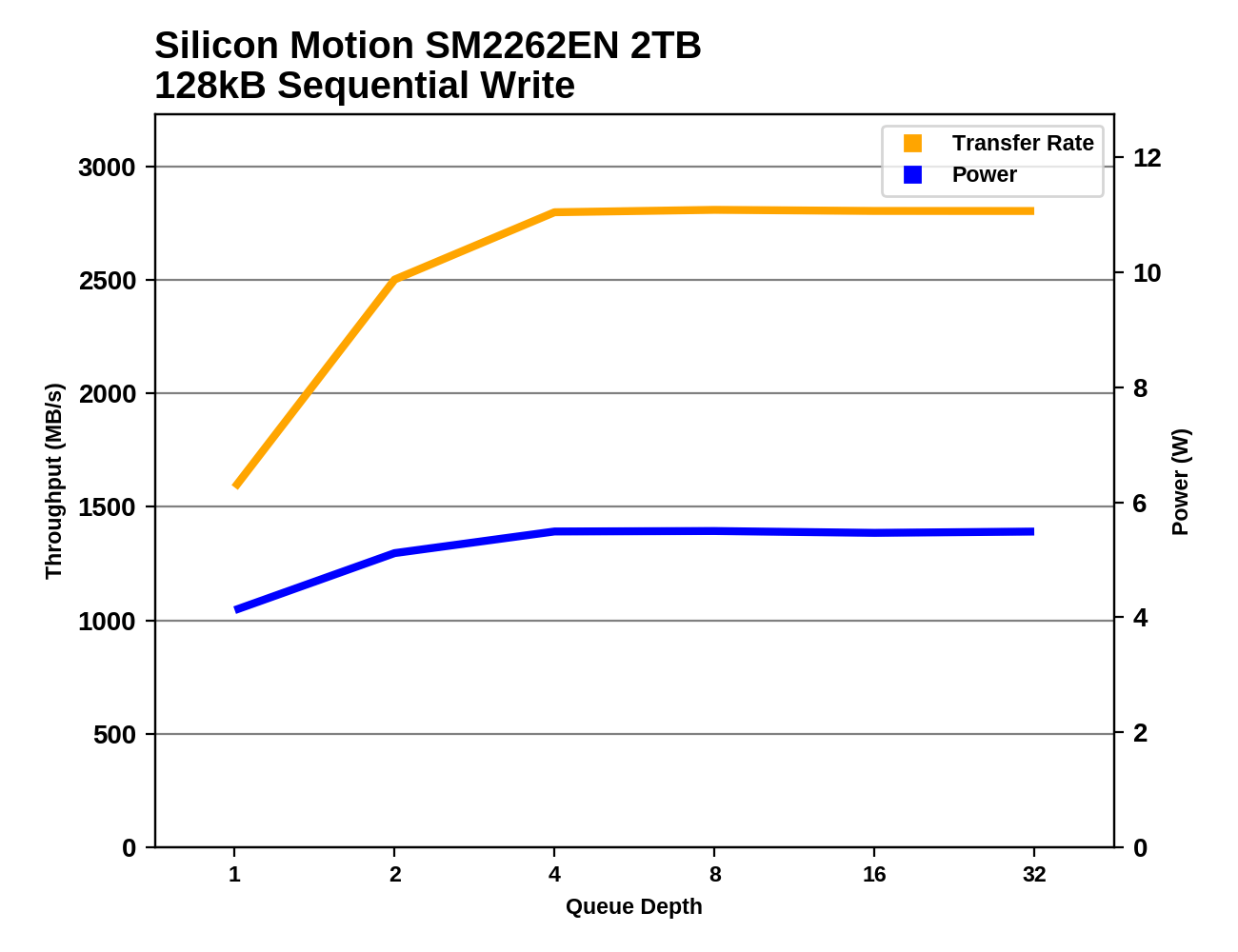 |
|||||||||
The SM2262EN takes a bit longer to reach its full sequential write speed than most drives, saturating only at QD4 or higher. But it would probably still be in first place among TLC drives if its performance stopped increasing at QD2 where it has a slight advantage over the 1TB 970 EVO.
Mixed Random Performance
Our test of mixed random reads and writes covers mixes varying from pure reads to pure writes at 10% increments. Each mix is tested for up to 1 minute or 32GB of data transferred. The test is conducted with a queue depth of 4, and is limited to a 64GB span of the drive. In between each mix, the drive is given idle time of up to one minute so that the overall duty cycle is 50%.
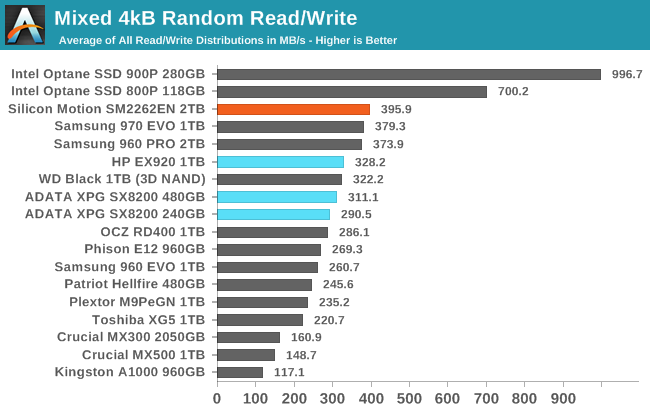
The Silicon Motion SM2262EN takes the lead among flash-based SSDs for mixed random I/O performance, though by a margin that is small enough that it may be due entirely to the capacity advantage over the 1TB 970 EVO. The performance is a clear improvement over the already-great HP EX920.
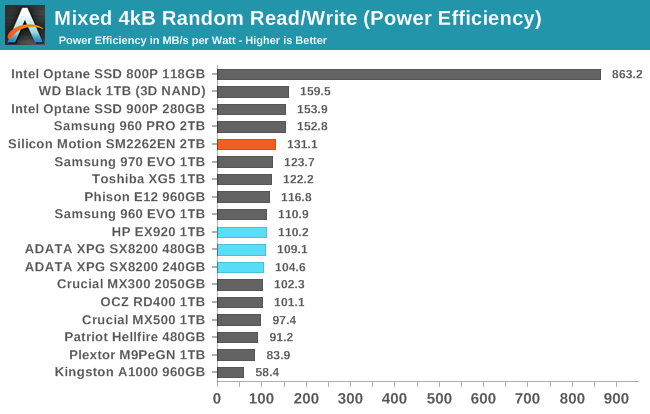 |
|||||||||
| Power Efficiency in MB/s/W | Average Power in W | ||||||||
Power efficiency for the SM2262EN has improved but is not quite in the top tier for flash-based SSDs. Total power draw is higher than most SSDs, but 3W isn't a problem given the performance.
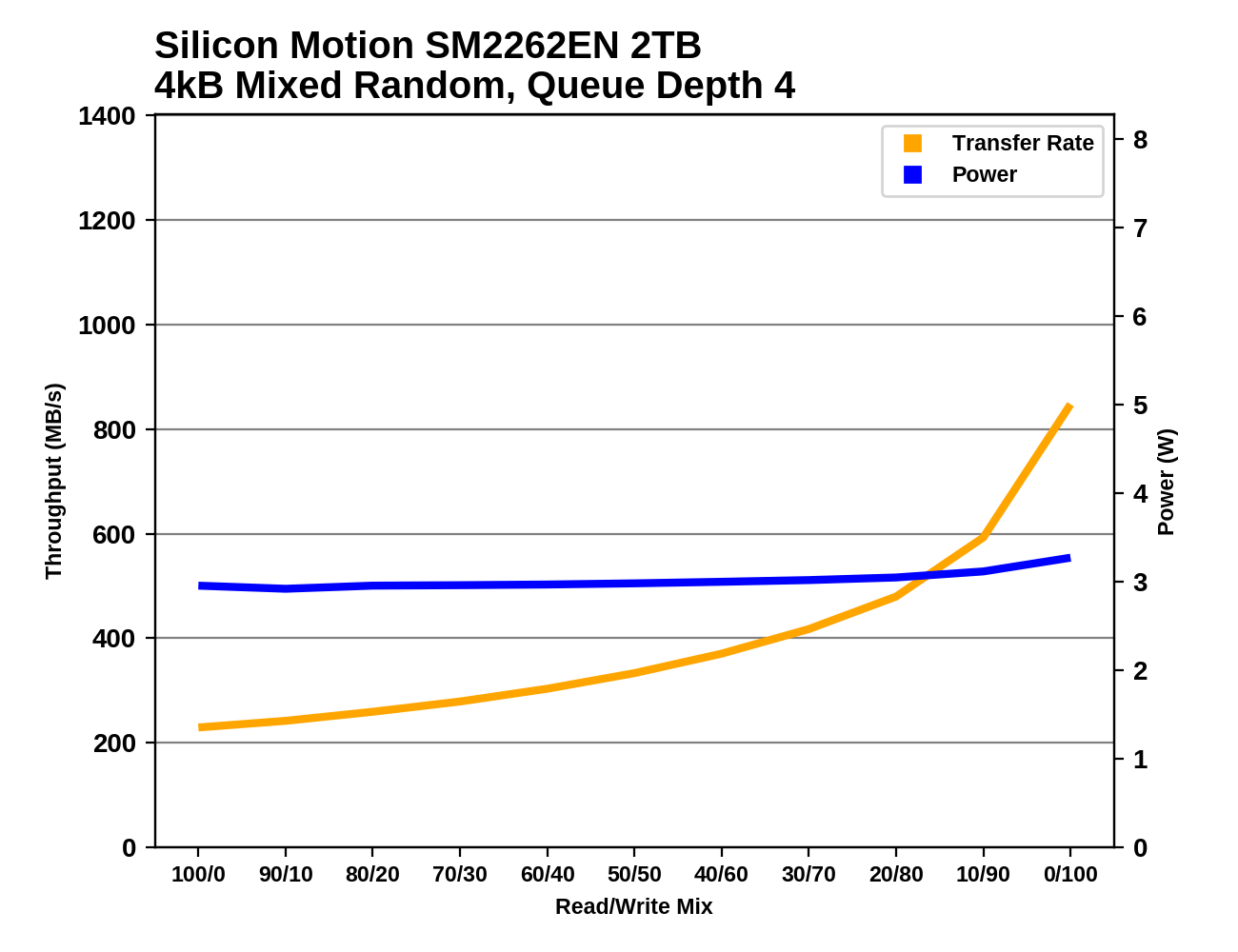 |
|||||||||
The SM2262EN shows very similar performance scaling to other top drives, with slow growth during the early phases of the test while the workload is still read-heavy, but accelerating as the proportion of writes increases. There are several drives that outperform the SM2262EN in the final phase of pure random writes, but the it tends to dominate all the earlier phases.
It is also interesting to note that power consumption barely ticks up for the final phase where the SM2262EN has a respectable spike in performance.
Mixed Sequential Performance
Our test of mixed sequential reads and writes differs from the mixed random I/O test by performing 128kB sequential accesses rather than 4kB accesses at random locations, and the sequential test is conducted at queue depth 1. The range of mixes tested is the same, and the timing and limits on data transfers are also the same as above.
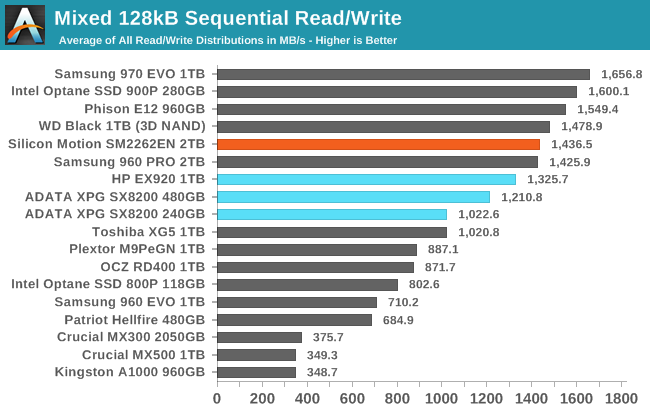
The SM2262EN is outclassed by several other TLC drives on the mixed sequential I/O test, but it is still clearly within high-end performance territory and is an improvement over the SM2262 drives.
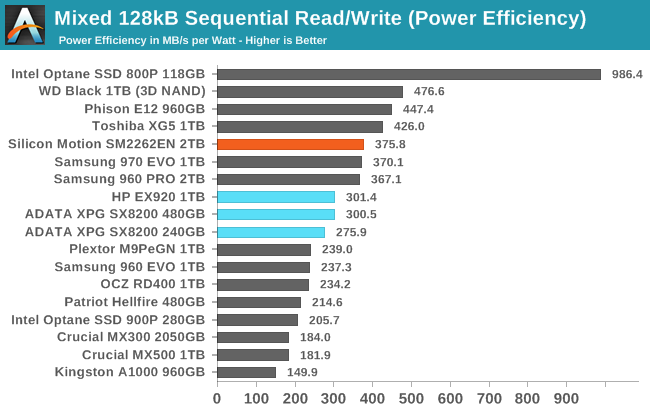 |
|||||||||
| Power Efficiency in MB/s/W | Average Power in W | ||||||||
The SM2262EN uses less power than its predecessors on this test while offering a modest performance improvement, so its efficiency score is substantially higher. However, several other TLC drives are still ahead, led by the WD Black.
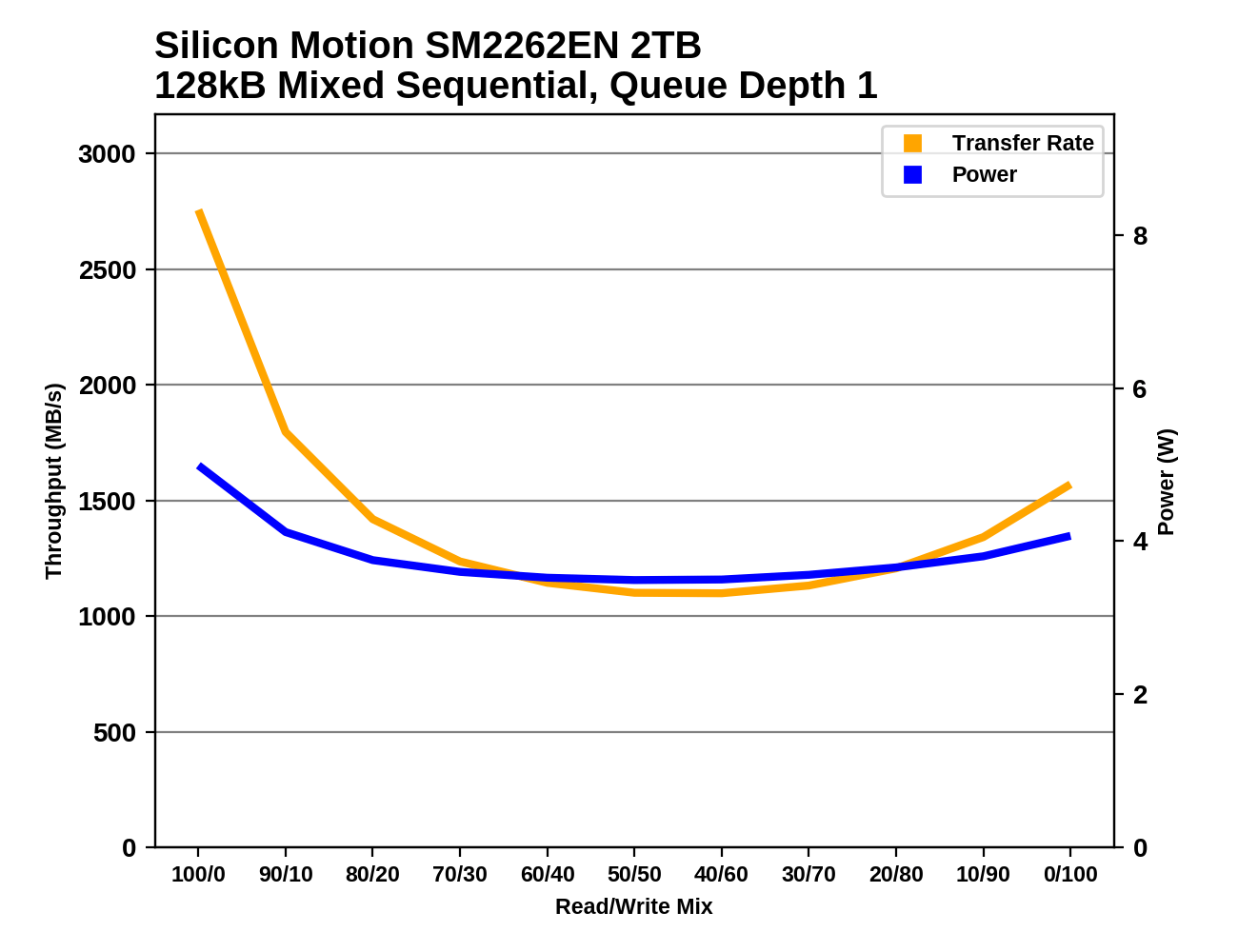 |
|||||||||
The performance scaling curve of the SM2262EN is very similar to the SM2262-based HP EX920, except that the EX920 falls behind during the more write-heavy half of the test. The SM2262EN manages to stay well above 1 GB/s throughout the test. The fastest drive run this test on is the Samsung 970 EVO, which doesn't lose performance as quickly as writes are added to the mix, but it ends up performing almost the same as the SM2262EN during the second half of the test.
Power Management Features
Real-world client storage workloads leave SSDs idle most of the time, so the active power measurements presented earlier in this review only account for a small part of what determines a drive's suitability for battery-powered use. Especially under light use, the power efficiency of a SSD is determined mostly be how well it can save power when idle.
For many NVMe SSDs, the closely related matter of thermal management can also be important. M.2 SSDs can concentrate a lot of power in a very small space. They may also be used in locations with high ambient temperatures and poor cooling, such as tucked under a GPU on a desktop motherboard, or in a poorly-ventilated notebook.
| SM2262EN Reference Design NVMe Power and Thermal Management Features |
|||
| Controller | Silicon Motion SM2262EN | ||
| Firmware | SVN112 | ||
| NVMe Version |
Feature | Status | |
| 1.0 | Number of operational (active) power states | 3 | |
| 1.1 | Number of non-operational (idle) power states | 2 | |
| Autonomous Power State Transition (APST) | Supported | ||
| 1.2 | Warning Temperature | 70 °C | |
| Critical Temperature | 80 °C | ||
| 1.3 | Host Controlled Thermal Management | Not Supported | |
| Non-Operational Power State Permissive Mode | Not Supported | ||
The pre-production firmware on our SM2262EN sample doesn't implement any of the NVMe 1.3 power or thermal management features, even though the current retail SM2262 drives support Host Controlled Thermal Management. The supported power states are unchanged from those on retail SM2262 drives.
| SM2262EN Reference Design NVMe Power States |
|||||
| Controller | Silicon Motion SM2262EN | ||||
| Firmware | SVN112 | ||||
| Power State |
Maximum Power |
Active/Idle | Entry Latency |
Exit Latency |
|
| PS 0 | 9.0 W | Active | - | - | |
| PS 1 | 4.6 W | Active | - | - | |
| PS 2 | 3.8 W | Active | - | - | |
| PS 3 | 45 mW | Idle | 2 ms | 2 ms | |
| PS 4 | 4 mW | Idle | 6 ms | 8 ms | |
Note that the above tables reflect only the information provided by the drive to the OS. The power and latency numbers are often very conservative estimates, but they are what the OS uses to determine which idle states to use and how long to wait before dropping to a deeper idle state.
Idle Power Measurement
SATA SSDs are tested with SATA link power management disabled to measure their active idle power draw, and with it enabled for the deeper idle power consumption score and the idle wake-up latency test. Our testbed, like any ordinary desktop system, cannot trigger the deepest DevSleep idle state.
Idle power management for NVMe SSDs is far more complicated than for SATA SSDs. NVMe SSDs can support several different idle power states, and through the Autonomous Power State Transition (APST) feature the operating system can set a drive's policy for when to drop down to a lower power state. There is typically a tradeoff in that lower-power states take longer to enter and wake up from, so the choice about what power states to use may differ for desktop and notebooks.
We report two idle power measurements. Active idle is representative of a typical desktop, where none of the advanced PCIe link or NVMe power saving features are enabled and the drive is immediately ready to process new commands. The idle power consumption metric is measured with PCIe Active State Power Management L1.2 state enabled and NVMe APST enabled if supported.
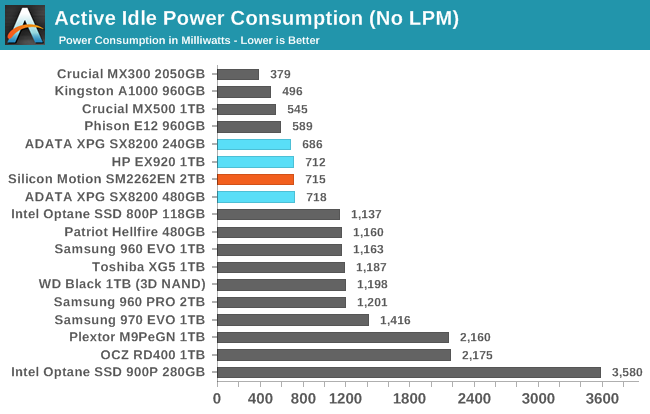
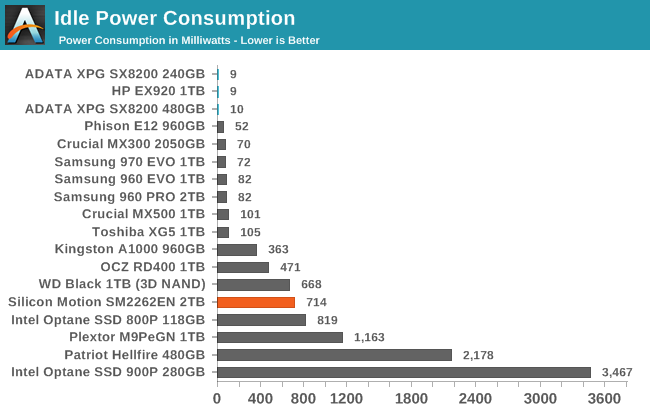
The active idle power consumption of the SM2262EN is the same as the SM2262, which is still pretty good by the standards of NVMe SSDs. However, the idle sleep states are broken on this drive, so turning on APST or even manually instructing the drive to enter one of its non-operational power states has no effect. This is a disappointing regression from the excellent power management we've seen from the SM2262, but I'm confident this issue can be fixed before drives hit the market.
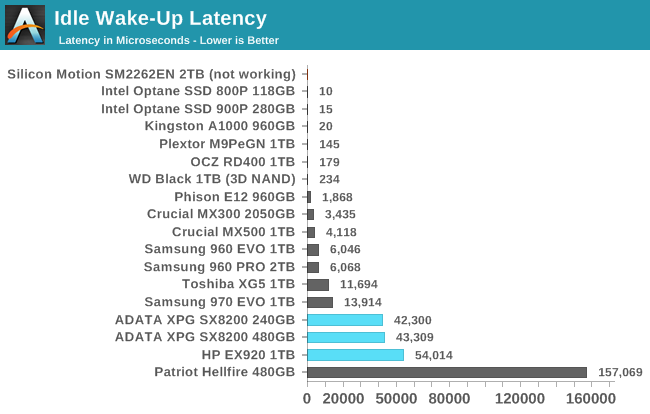
With idle power management currently broken on the SM2262EN, we can't see whether Silicon Motion has improved the wake-up latency. It's a bit high for the SM2262 drives, but since they also offer the best idle power on our testbed that can probably be forgiven.
Looking Forward
It's great to see that Silicon Motion is continuing to improve on the greatest performance weakness of flash-based SSDs: random read latency. The SM2262 provided a surprising jump in random read performance, surpassing even MLC SSDs. The SM2262EN takes things a bit further, and Intel's Optane SSDs now lead by only a factor of 6 or so. This kind of improvement has the greatest potential to improve real-world performance as perceived by end users, and random reads are the workload where flash-based SSDs are furthest from saturating the SATA or PCIe host interfaces. (The Intel/Micron 64L 3D TLC NAND probably deserves some credit for enabling these improvements, too.)
The SM2262EN is well-tuned to turn in stellar scores on many other benchmarks, and it is near the top of the charts for almost all of our synthetic benchmarks. However, it is clear that Silicon Motion is making some serious tradeoffs to attain these scores. The SM2262EN's performance degrades severely when the drive is full, and this effect seems to be even stronger than for the SM2262 drives we've tested. Silicon Motion has developed the fastest SLC write cache currently available, but once it's full, the situation isn't pretty.
For a 2TB drive like our review sample, I'm not too worried about these performance hits: it's pretty hard in practice to fill a really large SLC cache, and this isn't the easiest drive to fill up to 100% with real data. Our toughest benchmarks are well beyond the range of normal usage patterns, so abysmal scores there don't necessarily mean the drive is bad or unsuitable for power users. What it means is that Silicon Motion needs to be careful not to go too far with their optimization efforts. With the lower capacity drives that will account for the bulk of SM2262EN sales, it will be much easier to bump against the limits of which scenarios the controller can handle well. It may be necessary to use a much higher overprovisioning ratio on the lower capacity models, in order to ensure that they can maintain high performance even under heavy workloads. Products using the SM2262EN will live or die based on how well it can avoid falling into low-performing pits when presented with real-world workloads.
Idle power management seems to be broken on our SM2262EN sample, which is a disappointment because the SM2262 drives currently on the market offer the best trouble-free power management situation out of all the NVMe drives we've tested. Silicon Motion needs to ensure that this bug doesn't make it into retail products.
Consumer SSD prices have been declining for most of the year, in large part spurred by the adoption of 64L 3D TLC by the many brands that do not manufacture their own flash. Last year saw 64L 3D NAND hit the market in a limited number of products from the biggest players in the market, but now that NAND is in use everywhere and in plentiful supply. The downward trend is likely to continue in the near future, so even though the SM2262EN may command some premium over the base SM2262, the product lines that adopt the updated controller will probably do so at or below the current prices.
Looking further forward, we don't have much information about the rest of Silicon Motion's roadmap. We know they're working on PCIe 4.0 support, but this won't be needed in the consumer market anytime soon. They have also developed a new generation of more robust LDPC error correction intended to better support QLC NAND, and this will likely show up in the next generation of controllers from Silicon Motion. A full refresh of Silicon Motion's NVMe controller lineup is probably still at least a year away, so the SM2262EN may need to stay competitive for quite a while. It will probably be paired with 96L 3D NAND as soon as it is available, which may provide further incremental increases to performance and power efficiency.
The SM2262EN may also end up paired with QLC NAND for a very fast and cheap bulk storage drive. Such a drive would definitely benefit from the fast and aggressive SLC caching strategy used by the SM2262EN.


